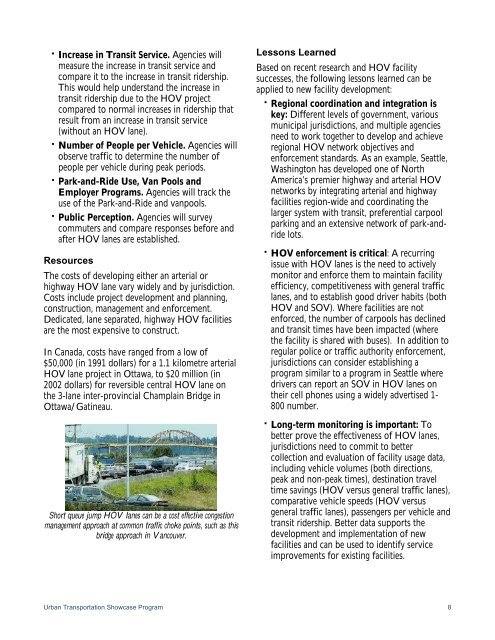High Occupancy Vehicle Lanes in Canada
High Occupancy Vehicle Lanes in Canada
High Occupancy Vehicle Lanes in Canada
You also want an ePaper? Increase the reach of your titles
YUMPU automatically turns print PDFs into web optimized ePapers that Google loves.
• Increase <strong>in</strong> Transit Service. Agencies will<br />
measure the <strong>in</strong>crease <strong>in</strong> transit service and<br />
compare it to the <strong>in</strong>crease <strong>in</strong> transit ridership.<br />
This would help understand the <strong>in</strong>crease <strong>in</strong><br />
transit ridership due to the HOV project<br />
compared to normal <strong>in</strong>creases <strong>in</strong> ridership that<br />
result from an <strong>in</strong>crease <strong>in</strong> transit service<br />
(without an HOV lane).<br />
• Number of People per <strong>Vehicle</strong>. Agencies will<br />
observe traffic to determ<strong>in</strong>e the number of<br />
people per vehicle dur<strong>in</strong>g peak periods.<br />
• Park-and-Ride Use, Van Pools and<br />
Employer Programs. Agencies will track the<br />
use of the Park-and-Ride and vanpools.<br />
• Public Perception. Agencies will survey<br />
commuters and compare responses before and<br />
after HOV lanes are established.<br />
Resources<br />
The costs of develop<strong>in</strong>g either an arterial or<br />
highway HOV lane vary widely and by jurisdiction.<br />
Costs <strong>in</strong>clude project development and plann<strong>in</strong>g,<br />
construction, management and enforcement.<br />
Dedicated, lane separated, highway HOV facilities<br />
are the most expensive to construct.<br />
In <strong>Canada</strong>, costs have ranged from a low of<br />
$50,000 (<strong>in</strong> 1991 dollars) for a 1.1 kilometre arterial<br />
HOV lane project <strong>in</strong> Ottawa, to $20 million (<strong>in</strong><br />
2002 dollars) for reversible central HOV lane on<br />
the 3-lane <strong>in</strong>ter-prov<strong>in</strong>cial Champla<strong>in</strong> Bridge <strong>in</strong><br />
Ottawa/Gat<strong>in</strong>eau.<br />
Short queue jump HOV lanes can be a cost effective congestion<br />
management approach at common traffic choke po<strong>in</strong>ts, such as this<br />
bridge approach <strong>in</strong> Vancouver.<br />
Lessons Learned<br />
Based on recent research and HOV facility<br />
successes, the follow<strong>in</strong>g lessons learned can be<br />
applied to new facility development:<br />
• Regional coord<strong>in</strong>ation and <strong>in</strong>tegration is<br />
key: Different levels of government, various<br />
municipal jurisdictions, and multiple agencies<br />
need to work together to develop and achieve<br />
regional HOV network objectives and<br />
enforcement standards. As an example, Seattle,<br />
Wash<strong>in</strong>gton has developed one of North<br />
America’s premier highway and arterial HOV<br />
networks by <strong>in</strong>tegrat<strong>in</strong>g arterial and highway<br />
facilities region-wide and coord<strong>in</strong>at<strong>in</strong>g the<br />
larger system with transit, preferential carpool<br />
park<strong>in</strong>g and an extensive network of park-andride<br />
lots.<br />
• HOV enforcement is critical: A recurr<strong>in</strong>g<br />
issue with HOV lanes is the need to actively<br />
monitor and enforce them to ma<strong>in</strong>ta<strong>in</strong> facility<br />
efficiency, competitiveness with general traffic<br />
lanes, and to establish good driver habits (both<br />
HOV and SOV). Where facilities are not<br />
enforced, the number of carpools has decl<strong>in</strong>ed<br />
and transit times have been impacted (where<br />
the facility is shared with buses). In addition to<br />
regular police or traffic authority enforcement,<br />
jurisdictions can consider establish<strong>in</strong>g a<br />
program similar to a program <strong>in</strong> Seattle where<br />
drivers can report an SOV <strong>in</strong> HOV lanes on<br />
their cell phones us<strong>in</strong>g a widely advertised 1-<br />
800 number.<br />
• Long-term monitor<strong>in</strong>g is important: To<br />
better prove the effectiveness of HOV lanes,<br />
jurisdictions need to commit to better<br />
collection and evaluation of facility usage data,<br />
<strong>in</strong>clud<strong>in</strong>g vehicle volumes (both directions,<br />
peak and non-peak times), dest<strong>in</strong>ation travel<br />
time sav<strong>in</strong>gs (HOV versus general traffic lanes),<br />
comparative vehicle speeds (HOV versus<br />
general traffic lanes), passengers per vehicle and<br />
transit ridership. Better data supports the<br />
development and implementation of new<br />
facilities and can be used to identify service<br />
improvements for exist<strong>in</strong>g facilities.<br />
Urban Transportation Showcase Program 8
















